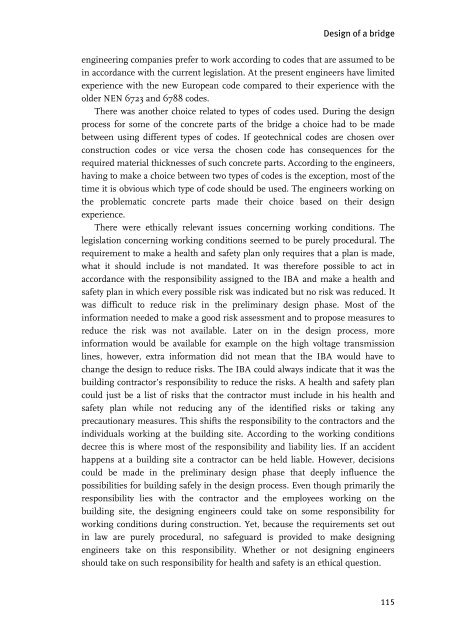Ethical issues in engineering design - 3TU.Centre for Ethics and ...
Ethical issues in engineering design - 3TU.Centre for Ethics and ...
Ethical issues in engineering design - 3TU.Centre for Ethics and ...
You also want an ePaper? Increase the reach of your titles
YUMPU automatically turns print PDFs into web optimized ePapers that Google loves.
Design of a bridge<br />
eng<strong>in</strong>eer<strong>in</strong>g companies prefer to work accord<strong>in</strong>g to codes that are assumed to be<br />
<strong>in</strong> accordance with the current legislation. At the present eng<strong>in</strong>eers have limited<br />
experience with the new European code compared to their experience with the<br />
older NEN 6723 <strong>and</strong> 6788 codes.<br />
There was another choice related to types of codes used. Dur<strong>in</strong>g the <strong>design</strong><br />
process <strong>for</strong> some of the concrete parts of the bridge a choice had to be made<br />
between us<strong>in</strong>g different types of codes. If geotechnical codes are chosen over<br />
construction codes or vice versa the chosen code has consequences <strong>for</strong> the<br />
required material thicknesses of such concrete parts. Accord<strong>in</strong>g to the eng<strong>in</strong>eers,<br />
hav<strong>in</strong>g to make a choice between two types of codes is the exception, most of the<br />
time it is obvious which type of code should be used. The eng<strong>in</strong>eers work<strong>in</strong>g on<br />
the problematic concrete parts made their choice based on their <strong>design</strong><br />
experience.<br />
There were ethically relevant <strong>issues</strong> concern<strong>in</strong>g work<strong>in</strong>g conditions. The<br />
legislation concern<strong>in</strong>g work<strong>in</strong>g conditions seemed to be purely procedural. The<br />
requirement to make a health <strong>and</strong> safety plan only requires that a plan is made,<br />
what it should <strong>in</strong>clude is not m<strong>and</strong>ated. It was there<strong>for</strong>e possible to act <strong>in</strong><br />
accordance with the responsibility assigned to the IBA <strong>and</strong> make a health <strong>and</strong><br />
safety plan <strong>in</strong> which every possible risk was <strong>in</strong>dicated but no risk was reduced. It<br />
was difficult to reduce risk <strong>in</strong> the prelim<strong>in</strong>ary <strong>design</strong> phase. Most of the<br />
<strong>in</strong><strong>for</strong>mation needed to make a good risk assessment <strong>and</strong> to propose measures to<br />
reduce the risk was not available. Later on <strong>in</strong> the <strong>design</strong> process, more<br />
<strong>in</strong><strong>for</strong>mation would be available <strong>for</strong> example on the high voltage transmission<br />
l<strong>in</strong>es, however, extra <strong>in</strong><strong>for</strong>mation did not mean that the IBA would have to<br />
change the <strong>design</strong> to reduce risks. The IBA could always <strong>in</strong>dicate that it was the<br />
build<strong>in</strong>g contractor’s responsibility to reduce the risks. A health <strong>and</strong> safety plan<br />
could just be a list of risks that the contractor must <strong>in</strong>clude <strong>in</strong> his health <strong>and</strong><br />
safety plan while not reduc<strong>in</strong>g any of the identified risks or tak<strong>in</strong>g any<br />
precautionary measures. This shifts the responsibility to the contractors <strong>and</strong> the<br />
<strong>in</strong>dividuals work<strong>in</strong>g at the build<strong>in</strong>g site. Accord<strong>in</strong>g to the work<strong>in</strong>g conditions<br />
decree this is where most of the responsibility <strong>and</strong> liability lies. If an accident<br />
happens at a build<strong>in</strong>g site a contractor can be held liable. However, decisions<br />
could be made <strong>in</strong> the prelim<strong>in</strong>ary <strong>design</strong> phase that deeply <strong>in</strong>fluence the<br />
possibilities <strong>for</strong> build<strong>in</strong>g safely <strong>in</strong> the <strong>design</strong> process. Even though primarily the<br />
responsibility lies with the contractor <strong>and</strong> the employees work<strong>in</strong>g on the<br />
build<strong>in</strong>g site, the <strong>design</strong><strong>in</strong>g eng<strong>in</strong>eers could take on some responsibility <strong>for</strong><br />
work<strong>in</strong>g conditions dur<strong>in</strong>g construction. Yet, because the requirements set out<br />
<strong>in</strong> law are purely procedural, no safeguard is provided to make <strong>design</strong><strong>in</strong>g<br />
eng<strong>in</strong>eers take on this responsibility. Whether or not <strong>design</strong><strong>in</strong>g eng<strong>in</strong>eers<br />
should take on such responsibility <strong>for</strong> health <strong>and</strong> safety is an ethical question.<br />
115



